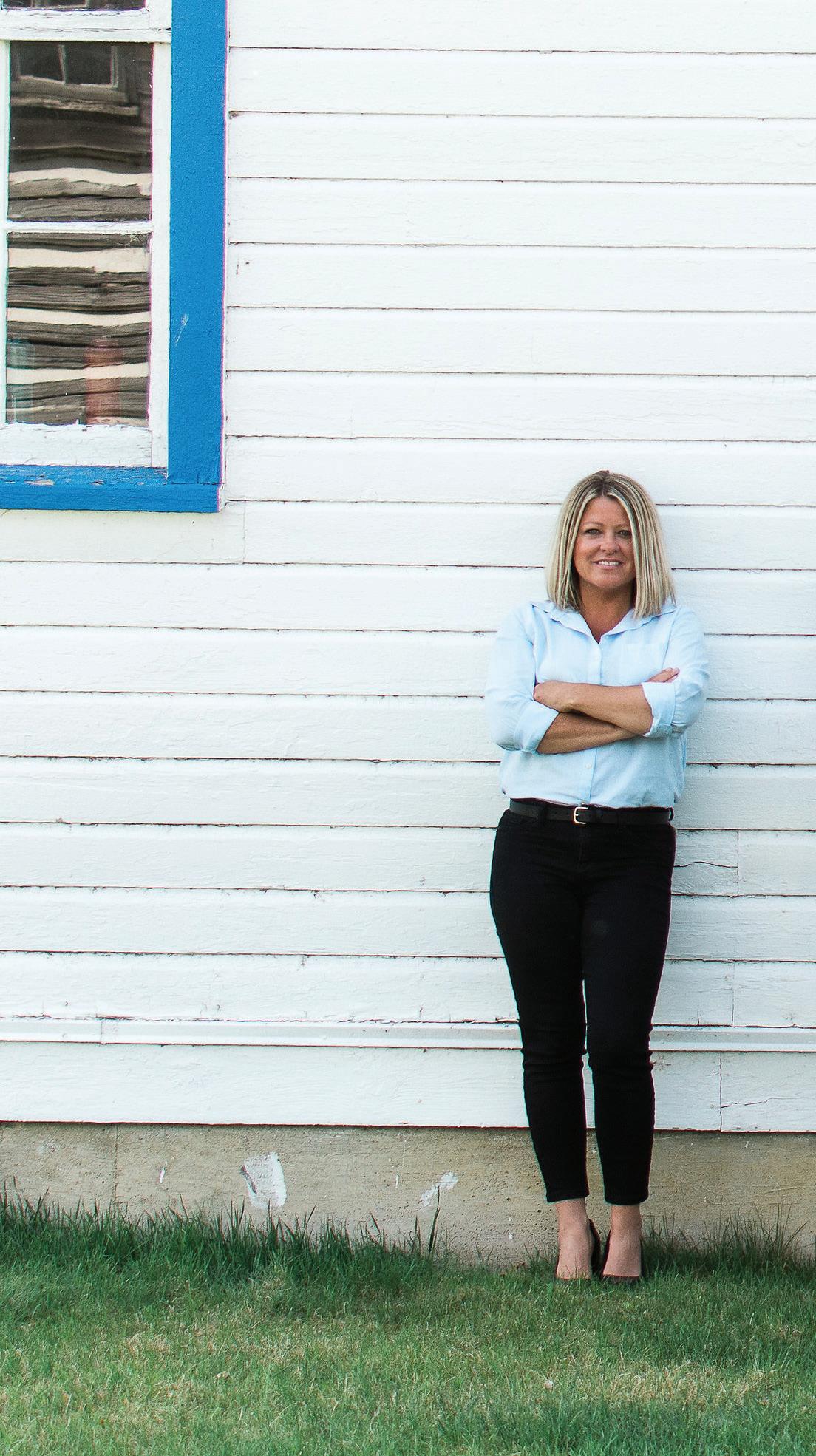
8 minute read
PHYSIO FACT
Golden rays dance across the sky. The temperature is climbing. Following imprisonment by the cuffs of winter, as proud Manitobans we soak-up summer. For many this may involve swinging the golf club, setting the beach volleyball, smashing the tennis ball or throwing a baseball. Though the scenes vary, and the equipment differs – these activities share a common dominator – the shoulder.
Shoulder pain is one of the most frequent musculoskeletal complaints and its prevalence increases with age. What makes the shoulder susceptible to pain is that it’s built for mobility. A shoulder’s structure can be compared to a golf ball on a tee; the ball being your humerus or your “arm bone” and the tee being the groove in your shoulder blade where the humerus sits. Movement of the shoulder is a dynamic dance between the boney surfaces, capsule, ligaments, and forces of the surrounding musculature.
Although several muscles are involved in shoulder movement, an important complex is the rotator cuff. The rotator cuff can be likened to a hand reaching from the back of shoulder blade to the front of the humerus– effectively grabbing onto the ball at the top. It is composed of four muscles that converge together to form an attachment deep within the shoulder joint. Our shoulder’s mobility is masterful for function; we can reach, rotate, and throw! However, its design leaves it prone to injury and strain, particularly under conditions in which it is overloaded.
Excessive tissue load -or “too much, too difficult, or too often” - remains the greatest factor in the development of rotator cuff related shoulder pain. This is reflected by the fact that it occurs more frequently in the dominant limb and with engagement in activities with high rates of upper-limb loading.
But, “it’s summer”. You still pick up your racket and whiz that neon ball across the court. Remember, pain is not always indicative of “damage”. The onset of mild dull, aching discomfort in the shoulder is normal with beginning or reengaging in an activity. But when that discomfort refuses to hibernate or progresses to sharp, debilitating pain that you cannot shake – consider visiting your local physiotherapist.
Upon review of the scientific literature, the best strategies for shoulder pain include physiotherapy. A physiotherapist is a medical professional who performs accurate and thorough assessments. Physiotherapy can help with management strategies, activity modification, improved strength, and flexibility. Attending physiotherapy is actively deciding to optimize your health by giving you the tools in your toolbelt to construct the life you desire.
Stacey Braun (Physiotherapist, MPT, B.Sc, ASc)
Presented by
pembinavalleyphysio.com
WORD
REBECCA DYCK editor
We are back for round two of Life in the Valley. This issue wouldn’t have been possible without our resilient business community. Their ability to pick themselves up and dust themselves off, always striving for a better tomorrow is inspiring. It’s what drives us to tell their stories and develop a narrative of supporting local.
What a crazy world we live in right now. As we were in the prepping stages of this issue and restrictions began to lift, we were hopeful that our businesses would be able to quickly get back into the swing of ‘normal’. While that has been the case for some, many others are still struggling. None of this has been easy for anyone. Everyone has had to overcome their own challenges, but through it all, a word that keeps coming to mind is grace.
Have grace for the people around you, for the different (sometimes slower) process of things, for the newness and strangeness of it all. Struggles always have a way of showing your true colours. I am so proud to live in a community whose colours have been strength and kindness and generosity and unity and love.
In the articles throughout this publication, we highlight the good. These stories have their ups and downs but they are stories of hope and success. As I read each one, I find that I learn so much about our area, the way things came to be and the people who worked hard to build something from the ground up. It’s exciting to see and hear that the same work ethic is alive and well today; new business owners willing to do what it takes to create something of their own.
This summer will be different. Plans have been altered and your holidays may not take you far, so take this opportunity to enjoy what our community has to offer. Hunker down with a good book . . . or magazine (hint hint) and appreciate the little things. I hope you enjoy what you find inside. Alejandro Penner
design lead photography
Ryan Wall
writer
Reese Derksen
graphic design
Tony Wall
graphic design
Kevin Friesen
sales
LIFE IN THE VALLEY
IS PUBLISHED BY SERIOUS MARKETING
admin@seriousmarketing.ca
204.325.0283
Carpentry


Community Futures
Have you ever wondered if you have what it takes to start your own business? Of course you have. It may have been as a kid, dreaming of how to enter the competitive market of roadside lemonade stands. Maybe you’re always looking to grow, take risks and overcome new challenges. It's human nature to want to make an impact on the world around you, and businesses are a powerful avenue in accomplishing this. Sadly, a majority of us reject our own dreams and ambitions in the name of being realistic, with fears and excuses continually driving a wedge between you and what could be. It doesn’t have to end here.
Business research shows that more and more successful businesses and business start ups are linked to competent consultants. They are tasked with guiding and coaching businesses through the challenging elements of ensuring the company succeeds.
Alana Bolton is the Business Development Manager at Community Futures, and has spent years coaching and developing aspiring entrepreneurs and business owners alike. She doesn’t get tired of hearing the same frequently asked questions over and over, and has made a career out of helping people take their good ideas, and turn them into a reality. Community Futures is a government funded, economic development agency, which offers this array of business services, all at no charge. These services have allowed their clients to grow their sales at a rate of over eight percent higher than those companies that go unassisted. Community Futures also provides lending to those that are capable of satisfying the requirements set for a loan, for up to $150,000.
“It always starts with plan” says Alana, as she explained the process of applying for a loan. “You need to get all your ideas down on paper and have things in place when starting a business.” As the old saying goes, if you fail to plan, you are planning to fail. A part of this planning is the financial end, including cash flow projections. Simply put, it’s an educated guess for the first year of your total revenue vs. total expenses. Alana supplies the template for this, which can be customized for each person’s unique set of circumstances. This step brings awareness to aspiring entrepreneurs and shows them how much business they will need to do in order to be sustainable. With this initial work put in, the risk involved with moving forward continues to decline, as preparation keeps people from blindly entering difficult situations. “What would your best and worst case scenarios look like?" “Are your revenue goals feasible?” These are the type of questions Alana asks to ensure your planning is as thorough as possible. Once the plan is submitted, Alana can examine each area to see if the business plan has what it takes to meet the agencies lending requirements. And if not, the dream isn’t over. Many great plans require going back to the drawing board, armed with helpful suggestions to improve upon initial work. Where other financial institutions might leave you with little hope after being denied a loan, this is where Community Futures thrives. “I’ll continue to assist you for months or even years” said Alana, who is willing to work with people until they get it right, offering years of business experience and resources. This relational take on lending also allows for people's stories to be heard and people's character to be discerned. What if you’ve gone bankrupt in the past but it wasn’t your fault? Or even if it was your fault, can you show that you’ve learned from the situation? While this would be deemed as higher risk lending, it is something Community Futures has always been willing to engage in and is the second chance many are looking for. When you have been approved for a loan, it’s on to the final steps such as a business number, tax number, setting up appropriate bank accounts, buying insurance and setting up legal matters with a lawyer. While Community Futures can’t provide all these unique services, they can point you in the right direction and help you find accredited people for the job. One of the less obvious advantages to this relationship is the available networking that can come with it. “Sometimes we see the need to connect our client with a mentor” says Alana, “someone with experience in a similar business as them.” These connections could simply be a monthly phone call or email, but it may be the very thing a less experienced owner needs to grow their business.
You might see Community Futures as a first responder in all things related to your business, as they look forward to offering their services long after the initial start up. Whether it's knowledge of different funding sources, questions you’ve had go unresolved, or the need for troubleshooting down the road, there continues to be cost free business consulting at your disposal. With the necessary resources now available, the invitation to pursue your passions and dreams is louder than ever.
Find Community Futures Heartland at cfheartland.ca or at (204) 239-0135.







